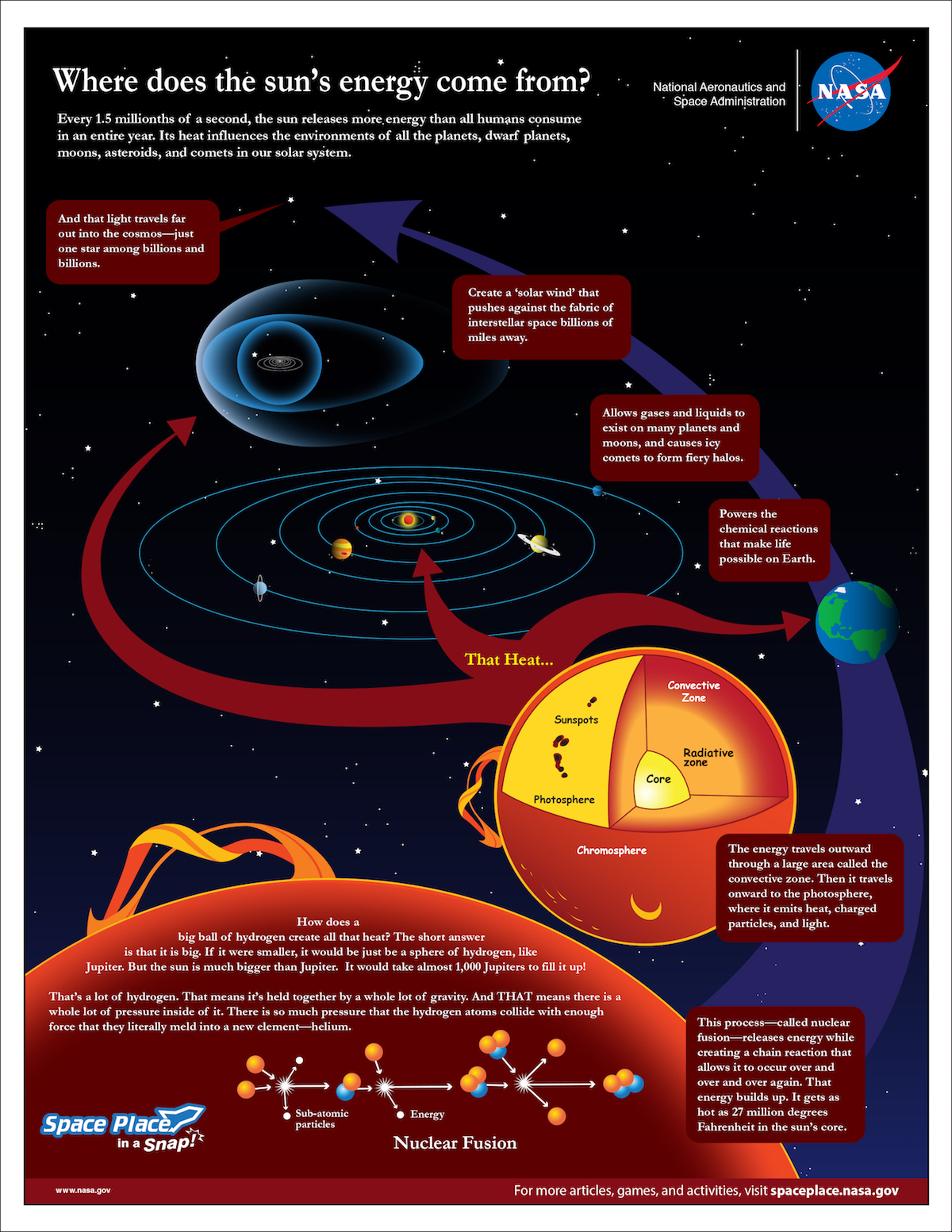The Sun creates energy through nuclear fusion, where hydrogen atoms combine to form helium, releasing immense amounts of heat and light. The process by which the Sun creates energy is a remarkable display of the power of nuclear fusion.
Through this process, hydrogen atoms within the Sun’s core fuse together to form helium, releasing an extraordinary amount of energy in the form of heat and light. This process, which occurs at incredibly high temperatures and pressures, allows the Sun to continually produce energy and sustain life on Earth.
Understanding the mechanisms behind the Sun’s energy production provides valuable insights into the fundamental forces that govern our universe, and the implications of this process extend far beyond our solar system. By unraveling the mysteries of solar energy creation, scientists continue to unlock the potential for harnessing this virtually limitless source of power for the benefit of humanity.

Formation Of The Sun
The Sun’s energy is created through a process called nuclear fusion, where hydrogen atoms combine to form helium, releasing vast amounts of energy in the process. This energy is then radiated as sunlight, providing heat and light essential for life on Earth.
Nuclear Fusion Reactions
Collapse Of A Molecular Cloud
The formation of the Sun is a fascinating process that involves both the nuclear fusion reactions and the collapse of a molecular cloud.
Nuclear Fusion Reactions
Nuclear fusion reactions play a crucial role in the formation of the Sun. These reactions involve the merging of lightweight atomic nuclei to form heavier nuclei, releasing a significant amount of energy in the process. In the case of the Sun, hydrogen nuclei combine to form helium through a series of fusion reactions.
This process starts with the collision of two hydrogen nuclei, which are both positively charged. Overcoming the repulsion between their positively charged protons requires extremely high temperatures and pressures. These conditions are only present in the core of the Sun, where temperatures soar to about 15 million degrees Celsius (27 million degrees Fahrenheit).
Once the hydrogen nuclei collide, they undergo a series of fusion reactions. In the first step, two hydrogen nuclei combine to form a deuterium nucleus, releasing a positron and a neutrino in the process. This deuterium nucleus then fuses with another hydrogen nucleus, creating a helium-3 nucleus and releasing another proton.
Finally, two helium-3 nuclei merge to produce a helium-4 nucleus, releasing two more protons as a byproduct. This final step is particularly important because it releases a massive amount of energy in the form of gamma rays. The energy generated by these fusion reactions is what powers the Sun, providing us with heat and light.
Collapse Of A Molecular Cloud
The collapse of a molecular cloud is another crucial factor in the formation of the Sun. Molecular clouds consist of vast collections of gas and dust in space. Gravity acts on these clouds, pulling the gas and dust particles closer together.
As the molecular cloud collapses, it starts to spin and flatten into a disc-like shape due to conservation of angular momentum. The central region of this disc becomes denser and hotter over time, ultimately leading to the birth of a protostar. The protostar continues to accrete more gas and dust from the surrounding disc as it grows in mass.
Eventually, the core of the protostar becomes dense enough and hot enough for nuclear fusion reactions to occur, marking the official birth of a star. The excess gas and dust in the surrounding disc form a protoplanetary disk, which later gives rise to planets and other celestial bodies in the solar system.
In conclusion, the formation of the Sun involves the remarkable processes of nuclear fusion reactions and the collapse of a molecular cloud. These processes provide us with the incredible energy and light that sustain life on Earth.

Nuclear Fusion In The Sun
The sun’s energy is generated through a process known as nuclear fusion. This process occurs in the sun’s core and involves the conversion of hydrogen into helium through a series of intricate reactions.
Proton-proton Chain Reaction
In the sun’s core, protons collide and undergo a series of reactions, leading to the formation of helium nuclei. This process, known as the proton-proton chain reaction, is the primary mechanism through which the sun produces energy.
Cno Cycle
Alternatively, the CNO cycle, which stands for carbon-nitrogen-oxygen, is another process through which the sun generates energy. In this cycle, carbon acts as a catalyst, facilitating the fusion of hydrogen nuclei into helium.
Energy Transport Within The Sun
The Energy Transport within the Sun is a complex process that involves the movement of energy from the core to the surface. This process plays a crucial role in sustaining the Sun’s energy output, which has significant implications for life on Earth.
Radiative Zone
In the Radiative Zone, energy is transported through electromagnetic radiation. This zone, extending from the core to about 70% of the solar radius, consists of highly dense and hot plasma. Photons generated in the core travel through this region, continually bouncing off the particles in the plasma. This constant interaction causes the photons to lose energy and gradually move towards the outer layers of the Sun, where they are eventually released as sunlight.
Convective Zone
The Convective Zone occupies the outermost 30% of the Sun’s radius and is characterized by convective motion. Here, energy is transported through the upward movement of hot plasma and the downward flow of cooler plasma. The heat generated in the core causes the hot plasma to rise, carrying energy to the surface. As the plasma cools, it sinks back down, creating a continuous cycle of energy transport that contributes to the Sun’s overall energy output.
Solar Atmosphere And Energy Emission
The solar atmosphere plays a crucial role in the process by which the Sun creates energy. It is in this region surrounding the Sun that various layers, such as the photosphere, chromosphere, and corona, come together to emit energy in the form of light and heat. Understanding these layers and how they contribute to energy production is essential in comprehending the functioning of our star.
Photosphere
The photosphere is the outermost layer of the Sun’s interior, where energy is primarily emitted. This visible surface of the Sun is responsible for the vast majority of the light and heat we receive from our star. The photosphere is composed of a dense layer of hot gases, primarily hydrogen and helium. As these gases collide and interact, they release huge amounts of energy, radiating light and heat into space.
Chromosphere
Sitting just above the photosphere is the chromosphere, a thin layer of hot and glowing gases surrounding the Sun. The chromosphere is significantly less dense than the photosphere but emits energy in a different range of colors. During a total solar eclipse, this layer becomes visible as a shimmering red ring around the darkened Moon. The chromosphere is also responsible for producing phenomena like solar flares and prominences, which eject plasma and energy into space.
Corona
Extending far beyond the chromosphere is the corona, the outermost layer of the Sun’s atmosphere. This extended region consists of extremely hot and tenuous gases, reaching temperatures of over a million degrees Celsius. Unlike the photosphere and chromosphere, the corona cannot be observed directly without specialized instruments or during a total solar eclipse. The corona emits energy as highly charged particles and streams of plasma, creating the solar wind that continuously flows outwards from the Sun.
Each layer of the solar atmosphere plays a unique role in energy emission, contributing to the constant release of light and heat that sustains life on Earth. By studying these layers and understanding their mechanisms, scientists are continually uncovering insights into the processes that power our Sun and the universe as a whole.
Solar Wind And Energy Transfer
In the fascinating process of creating energy, the Sun relies on an intricate system involving solar wind and energy transfer. Solar wind, a continuous stream of charged particles emitted by the Sun, plays a crucial role in the distribution of solar energy throughout our solar system. Additionally, solar flares and coronal mass ejections are significant events that impact this energy transfer process. In this section, we explore the captivating aspects of solar wind and its connection to solar flares and coronal mass ejections.
Solar Flares
Solar flares are explosive bursts of high-energy radiation that occur near the surface of the Sun. These dynamic events release tremendous amounts of energy in the form of electromagnetic radiation, including X-rays and ultraviolet light. During a solar flare, massive amounts of charged particles are accelerated to nearly the speed of light.
- Solar flares contribute to the intricate dance of energy transfer within the Sun.
- These powerful bursts impact the Sun’s magnetic field, creating disturbances within it.
- These disturbances can result in the release of energetic particles into space, further enabling energy distribution.
- When solar flares occur, they can disrupt satellite communications and power grids on Earth.
Coronal Mass Ejections
Coronal mass ejections (CMEs) occur when the solar corona releases a tremendous amount of plasma and magnetic field. These eruptions can release billions of tons of solar material into space at speeds exceeding millions of miles per hour.
- CMEs play a vital role in the solar wind and energy transfer process.
- When a CME occurs, it launches a massive cloud of charged particles into space.
- These particles carry strong magnetic fields that can interact with the Earth’s magnetic field.
When the solar wind, solar flares, and CMEs interact with the Earth’s magnetosphere, they can produce captivating phenomena such as the Northern Lights or auroras in the polar regions. Additionally, these events can also impact our technology and infrastructure, making it crucial to understand the complex process by which the Sun creates energy and transfers it throughout the solar system.

Credit: spaceplace.nasa.gov
Frequently Asked Questions On What Is The Process By Which The Sun Creates Energy
How Does The Sun Create Energy?
Nuclear fusion is the mechanism by which the sun generates energy. In its core, hydrogen atoms fuse together to form helium, releasing an enormous amount of energy in the process. This energy is in the form of light and heat, which radiates outwards and sustains life on Earth.
What Role Does Gravity Play In The Sun’s Energy Creation?
Gravity plays a crucial role in the sun’s energy creation process. It acts as a gravitational force, compressing the core of the sun, allowing the hydrogen atoms to collide and fuse together. This fusion releases energy in the form of light and heat, keeping the sun shining brightly.
How Long Does It Take For The Sun To Create Energy?
The process of energy creation in the sun is ongoing and has been happening for billions of years. It takes approximately 100,000 years for the energy generated in the sun’s core to reach its surface. From there, it travels to Earth in about 8 minutes and 20 seconds, reaching us as sunlight.
Conclusion
To sum up, the process by which the sun creates energy is a fascinating and essential phenomenon. Through the incredible process of nuclear fusion, the sun converts hydrogen into helium, releasing an enormous amount of energy in the form of heat and light.
This process sustains life on Earth and powers various natural phenomena. Understanding how the sun creates energy allows us to appreciate its critical role in our existence and fuels ongoing research in renewable energy sources.

